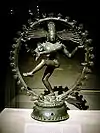Vibhuti
In Hinduism, vibhuti (Sanskrit: विभूति, romanized: vibhūti), also called bhasma or tirunīru, is sacred ash made of burnt dried wood, burnt cow dung and/or cremated bodies used in Agamic rituals.[1] Devotees of Shiva apply vibhuti traditionally as three horizontal lines across the forehead (also known as tripundra) and other parts of the body.[2]

According to the Shiva Purana, the particles of ash which cling to the skin when tripundra is applied are to be considered to be individual lingams. The scriptures further state that bhasma purifies the soul and elevates the devotee of Shiva, and that works done without wearing bhasma are fruitless. There are various methods for the application of the ashes, according to the Shiva Purana, and various mantras to be recited during application.
| Part of a series on |
| Shaivism |
|---|
 |
|
|
Other uses
Another meaning of vibhuti is a 'glorious form', in contrast with avatar, a reincarnation of Brahman.[3]
Vaishnava theology describes a vibhuti as 'incarnation of power', a temporary occasional manifestation such as when holy men are infused with divine virtues and qualities are infused.[4]
Sri Aurobindo mentions a vibhuti as "the hero of a race's struggle towards divine achievement, the hero in the Carlylean sense of heroism, a power of God in man."[5]
References
-
- Apte, Vaman Shivram. "A Practical Sanskrit Dictionary" p. 866.
- Making ash - the fire is lit on Sivaratri The Hindu, 2019-02-28.
- Lochtefeld, James G. (2002). The Illustrated Encyclopedia of Hinduism: N-Z. Rosen. pp. 748–749. ISBN 978-0-8239-3180-4.
- Kapoor, Subodh (1 January 2004). An Introduction to Epic Philosophy: Epic Period, History, Literature, Pantheon, Philosophy, Traditions, and Mythology. Cosmo Publications. p. 342. ISBN 9788177558807.
- Dhavamony, Mariasusai (1 January 2002). Hindu-Christian Dialogue: Theological Soundings and Perspectives. Rodopi. p. 75. ISBN 9042015101.
- Aurobindo, Sri (1 January 1992). Wisdom of the Gita: Second Series. Lotus Press. p. 21. ISBN 9780941524759.
Further reading
- Dictionary of Hindu Lore and Legend (ISBN 0-500-51088-1) by Anna Dallapiccola
